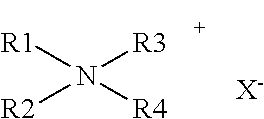Stabilized oil-in-water emulsions including agriculturally active ingredients
a technology of oil-in-water emulsion and agricultural active ingredients, which is applied in the field of stable, agricultural oil-in-water emulsion compositions, and can solve the problems of unused emulsion types
- Summary
- Abstract
- Description
- Claims
- Application Information
AI Technical Summary
Benefits of technology
Problems solved by technology
Method used
Image
Examples
example 1
Effect of Polymeric Surface Active Agent on Oil-in-Water Emulsion Stability in Salt Environment
[0073]In order to illustrate the effect of polymeric surface active agents on oil-in-water emulsion stability in a salt environment, a model emulsion including soybean oil was developed as shown in Table 1.
[0074]
TABLE 130% soybean oil emulsionwt %Oil phaseSoybean Oil30.0Brij 722.0Tween 611.5Aqueous phaseCedepal TD-4070.68Propylene Glycol10Water55.82
The developed model soybean oil emulsion was very stable. The emulsion did not experience any increase in particle size at Freeze / Thaw and 54° C. over a 2 week period.
[0075]Next, a similar emulsion was made including 0.01 M sodium chloride. The formulation is listed in Table 2.
[0076]
TABLE 230% soybean oil EcoZome with 0.01M NaClwt %Oil phaseSoybean Oil30.0Brij 722.0Tween 611.5Aqueous phaseCedepal TD-4070.68NaCl0.06 (0.01M)Propylene Glycol10Water (balanced ingredient)55.8
[0077]The soybean oil emulsion with 0.01 M NaCl was unstable. Phase separati...
example 2
Effect of Salt Concentration on Emulsion Stabilized by Polymeric Surfactant
[0081]The effect of salt concentration on an emulsion stabilized by a polymeric surfactant was investigated at a model formulation shown in Table 5. The salt concentration was varied at 0.4 M, 0.5M and 0.6M.
[0082]
TABLE 530% soybean oil ecozome with 4% Toximul 8223and 0.4M, 0.5M & 0.6M NaClwt %Oil phaseSoybean Oil30.0Brij 722.0Tween 611.5Aqueous phaseCedepal TD-4070.68Toximul 82234NaCl2.34 (0.4M); 2.92 (0.5M); 3.51 (0.6M)Propylene Glycol10Waterbalanced ingredient
[0083]It was found that at 0.4M NaCl concentration, the sample was stable after 2 weeks at 54° C. and Freeze / Thaw (temperature cycled from 40° C. to −10° C. every 24 hours), while at higher salt concentrations (0.5 M & 0.6M), samples were stable after 2 weeks at 54° C., but oil droplets started growing after 2 weeks at F / T.
example 3
Effect of Polymeric Surfactant Concentration on the Stability of Emulsion at Salt Environment
[0084]The effect of polymeric surfactant concentration on the stability of EcoZomes at salt environment was studied using a model system shown in Table 6.
[0085]
TABLE 630% soybean oil ecozome with 0.4MNaCl & 0.5%, 2% & 4% Soprophor 796 / Pwt %Oil phaseSoybean Oil30.0Brij 722.0Tween 611.5Aqueous phaseCedepal TD-407 MFLD0.68Soprophor 796 / P0.5; 2; 4NaCl2.34 (0.4M)Propylene Glycol10Waterbalanced ingredient
[0086]In this example, the salt concentration was fixed at 0.4M, while the concentration of Soprophor 796 / P was varied from 0.5% to 4%. It was found that there may exist an optimized polymer surface active agent concentration. At 2% of Soprophor 796 / P concentration, the emulsion was relatively stable at both 54° C. and F / T conditions, while increasing or decreasing polymeric surface active agent concentration showed less stable behavior including phase separation in both samples after two weeks in...
PUM
 Login to View More
Login to View More Abstract
Description
Claims
Application Information
 Login to View More
Login to View More - R&D
- Intellectual Property
- Life Sciences
- Materials
- Tech Scout
- Unparalleled Data Quality
- Higher Quality Content
- 60% Fewer Hallucinations
Browse by: Latest US Patents, China's latest patents, Technical Efficacy Thesaurus, Application Domain, Technology Topic, Popular Technical Reports.
© 2025 PatSnap. All rights reserved.Legal|Privacy policy|Modern Slavery Act Transparency Statement|Sitemap|About US| Contact US: help@patsnap.com



